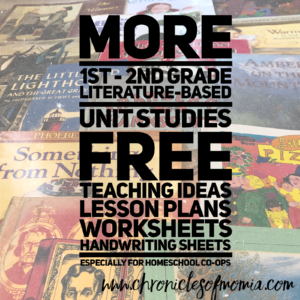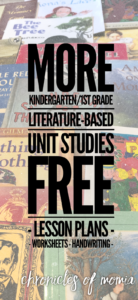Learning Snippets of History through Literature – the 2nd Year – More FIAR – Inspired Literature Based Lesson Plans

Learning Snippets of History through Literature
A FIAR – Inspired Literature Based Curriculum for Homeschool Co-ops
If you’re looking for something similar for upper-elementary, check out the Learning the USA through Literature Curriculum, recommended for 2nd – 4th.
If you’re looking for something similar for younger children, Learning the ABC’s through Literature is the series that started it all, and is recommended for 4-6 year olds. I spent so much time creating my own worksheets, gathering materials, and coming up with ideas for my own co-op, that I thought it would be worth it to keep a solid record of them to return to if I do the class again, and because I wish I had been able to find something like this when I started teaching at our local co-op.
This year includes 25 more books, complete with lessons, games, printables, and everything you need for a 1 hour co-op class. Most of these books are from the FIAR (Five-in-a-Row) curriculum, by Jane Lambert. A handful are not, but are excellent books that we thought would be great to include in our school year.
(The Memory Coat, Something from Nothing, Fiona’s Lace, The Story of St. Valentine and The Story of St. Patrick are not from the FIAR curriculum, but they are great stories and fit along well with other lessons I was already trying to fit in)
A Note for Those Using this for a Homeschool Co-op
What’s Included?
Why No Science or Art?
These lesson plans include Geography, Language Arts, History, Class Sharing, and an occasional Cooking Project. They DO NOT include Science or Art. Why not?
When we did this within our Homeschool Co-op, we were working with 3 1-hour blocks of time. I used this class to introduce the story, and used these lessons in the first hour, which was a longer block of time. A second teacher planned science lessons for the 2nd hour. A third teacher planned art lessons for the 3rd hour. (she also used the handwriting sheets that appear at the bottom of each lesson in her class). The reason I did not include art or science is because most of these books have many options for art and science lessons within the Five in a Row Manuals. Also, it is just as easy to go to Pinterest, type in the name of the book, and find dozens of projects. Then you just collect the needed materials, and use it with your class. The Language Arts / Geography / History – I thought we could use a little more help with. Also, some co-ops have a separate art and science curriculum. So if Art and Science were left off, this still can stand on it’s own as a full, extremely educational class.
Can each lesson plan be used alone?
Is there a reason for the order of lessons?
The books were shared in the order listed below. Can they be used in another order or by themselves? Yes, of course. However, each lesson includes a “Review” section, which emphasizes a few themes that were taught in prior weeks. If you use these lessons on their own, you can skip this section. However, these books were placed in this order for a reason. There are sections of books that cover the same theme. When I was Young in the Mountains, Amber on the Mountain, and Daniel’s Duck, all cover life in the mountains. The Memory Coat and Fiona’s Lace cover immigration and starting out in a new country. They Were Strong and Good, Grandfather’s Journey, and All Those Secrets of the World cover themes about family and war. Cranberry Thanksgiving is placed right around Thanksgiving, Stopping by Woods on a Snowy Evening is placed right as winter is starting (we used it right before our co-op took it’s winter long winter break), and Paul Revere’s Ride should fall in April, right when he took the famous ride in 1775. The Story of St. Valentine and The Story of St. Patrick were planned to coincide with the holidays, are are wonderful stories to know even if you don’t celebrate either of the holidays. Follow the Drinking Gourd, times up with Black History Month, and Mrs. Katz and Tush with Passover.
Each “Review” section enables you to reinforce lessons taught the previous week, and draw ties to the new story. Multiple books on the same theme helped to bring home the lessons and experience as well.
What ages / grades is this appropriate for?
These lesson plans were used with 1st and 2nd graders, though we had a few kindergarteners within our class. It could easily be used in a co-op setting for third or fourth grade, as well.
We have “non-writers” in our coop – can they use this?
We had several kindergarteners and 1st grade non-writers in the class with us. They usually just got a little extra help from our teaching assistant. So even though there are lessons that ask for writing, we have tried to keep the writing to a minimum, with the option for small bits of writing for those who want a challenge.
You cover some hard themes!
Yes, it’s true. We cover persecution, dying and suffering for the Lord, black history and slavery, the holocaust, deep failures of men, poverty, starvation, etc. For more of my heart on this, you can see what I wrote when we read The Story of St. Patrick by The Voice of the Martyrs.
Of course, as a teacher, you can take liberties to share as much or as little of these things as you feel comfortable with. However. I will mention this. I have been teaching these classes and covering “hard books” within the classroom, in Sunday School, and with my own children for many years. You know what I’ve noticed? When you start sharing the hard things – they notice. They get serious. They listen. And the connect with that story far more than a silly nonsense story. So I say, share the hard things. Share it in the context of “this is somehing horrible that happened” or “this is sad” or “this is something that never should have happened” … but God. But God used this. But God redeemed this. But God heard when his people called. But God saw. But God will reward greatly.
We live in a world of hard things, the Bible is full of His people encountering hard things, men and women who suffered deeply, but overcame. This is the lesson I want to share with our children. Hard things will happen – “all who desire to live a Godly life in Christ Jesus, will be persecuted” 2 Tim 3:12. But to hear stories of men and women who went through great difficulties -and prevailed. How encouraging, inspiring, and a wonderful preparation for our children growing up in the 21st century America.
Have you used this in your co-op?
Do you have any questions, suggestions, or comments?
If you do end up using this with your co-op – awesome! I would love to hear from you, see pictures of your class in action, or find out how things worked or didn’t work for your class. Since I’ve only done this one year, with one class – your feedback is soo helpful when going forward and tweaking this curriculum. Follow along on Instagram @chronicles_of_momia, and hashtag your post, #learningthroughliteraturehomeschoolcoopcurriculum (its long, I know). Or leave a comment at the bottom of this post, or the individual lessons. Thanks for checking this out! May it bless you in the years and months as you use it.
♥ Katherine Pittman

The books are in the recommended order, below. Click on the text to get to see the lesson plans, teaching handouts, worksheets, supply list, etc to go along with each book.
 Little Nino’s Pizzeria by Karen Barbour
Little Nino’s Pizzeria by Karen Barbour
 Storm in the Night by Mary Stolz
Storm in the Night by Mary Stolz
Mike Mulligan and the Steam Shovel by Virginia Lee Burton
The Little Red Lighthouse and the Great Grey Bridge by Hildegarde Swift
When I was Young in the Mountains by Cynthia Rylant
Amber on the Mountain by Tony Johnson
Daniel’s Duck by Clyde Robert Bulla
They Were Strong and Good by Robert Lawson
Grandfather’s Journey by Allen Say
All Those Secrets of the World by Jane Yolen
Cranberry Thanksgiving by Wende and Harold Devlin
The Glorious Flight by Alice and Martin Provenson
Stopping by Woods on a Snowy Evening by Robert Frost
The Memory Coat by Elvira Woodruff
Fiona’s Lace by Patricia Polacco
Warm as Wool by Scott Russell Sanders
The Story of St. Valentine by The Voice of the Martyrs
Follow the Drinking Gourd by Jeanette Winter
The Story of St. Patrick by The Voice of the Martyrs
Mrs. Katz and Tush by Patricia Polacco
Something from Nothing by Phoebe Gilman
Andy and the Lion by James Daughterty
The Bee Tree by Patricia Polacco
Paul Revere’s Ride by Henry Wadsworth Longfellow



























Nora! No trouble at all… you are just the person I need to use everything, comb through it, and let me know what’s missing! I’m sure there are dozens more people that are grateful for your “bothering.” When I first did these classes, I was often working late into the night, printing things at the last minute for early morning classes the next day. Sometimes returning after co-op to upload something to the website. In the midst of it all, obviously, many things got lost. I was never trying to really make the site beautiful (though someday I’d love to if I have more time) … more just trying to be a blessing to others and share what I was doing in the process. But corrections and feedback really do help to make it better. There are hundreds of people who use these pages every month and the feedback and corrections are likely helping co-ops everywhere. so… thank you!
Oh No! I’m on to Fiona’s Lace this week, and I can’t print this handwriting sheet either. Hopefully you get this message before tomorrow! Thank you!
Will look for it Nora and see if I can get it up before tonight, thanks for letting me know
Nora—it’s updated. Again, thank you for bringing these to my attention.
I am trying to print the handwriting sheet for The Memory Coat, but it doesn’t look like there’s a printable version. Can I find it somewhere else on the site? Thank you for this curriculum! This is my second year using it, and it’s a lifesaver! God bless!
Nora! So glad for the feedback and glad this has been a blessing to your family. Also—Thank you for bringing this to my attention! (if you find other missing things, please keep coming back to tell me!) I updated the page and added the PDF version … hope this helps!
Thank you so much! I use it for our co-op. Last year I did the 3rd year, but this year I’m using the 2nd year because they changed the grades of my class. I would not be able to teach our co-op without all your hard work. I have no idea how I did it before finding you! May God bless you and your family ABUNDANTLY!
I am a grandmother home-educating a special needs 1st grader and his almost-5 year old brother. We have used FIAR this year and the year prior, and really enjoyed the curriculum. I am just finding your website – wonderful! Just curious, you are writing primarily for co-ops; what is your opinion of FIAR as a central part of a curriculum (we supplement with other Science, and Art, and of course have the 3 R’s covered)? We have used FIAR year 1, this year – FIAR 2, considering using FIAR 3 next year (grade 2, K) and supplementing with some of your books and instructional material in your K-3 curriculum. That would give us a bridge to your year 4 material- traveling around the USA in literature. Again, thinking of “FIAR-plus” as the key curriculum piece… some days I feel guilty as it seems too simple and fun! Thoughts?
Hi Amy! Thanks for you comment and glad you are finding this site helpful :). I wrote these extra materials for a co-op because I recognized that many people do use the FIAR curriculum with a co-op, but of course the curriculum is written for an individual student and I wanted to tweak it specifically for the classroom setting. I also wanted to make sure my kids were going to get to enjoy many of the FIAR activities and books – but if left to myself and my busy day, we didn’t always have time to do everything at home. Teaching at co-op gave me the accountability to make sure some of the extra fun stuff still happened :). That being said, if you are covering your reading, math, and phonic/grammar with another workbook… I think five in a row is more than enough. Especially if you use volume 4. Those lessons are designed to take two weeks, and they have many many ideas that you can springboard off of, especially for writing and science and research. It is really a lot more in-depth. But yes, Five in a Row / FIAR is wonderful – it’s learning at its best, where the kids enjoy it, and because they enjoy it, they remember what they’re learning. So I’m not a FIAR expert, but I think it’s a wonderful curriculum.
This resource is AMAZING! I stumbled upon it from Google and the amount of work you have put into these studies is awesome. I am bookmarking this page to use with my kindergartner this year and I’m going to tell all my kindergarten mom friends about it. Thank you!
Thanks Surya! It was a labor of love and time – but so glad you and others are able to benefit. Thanks for sharing it around 🙂
I love you for this! thank you! 🙂
thanks, Maraly! It’s something I wished I could have found when I was starting to teach at co-ops – hopefully it will be useful to others